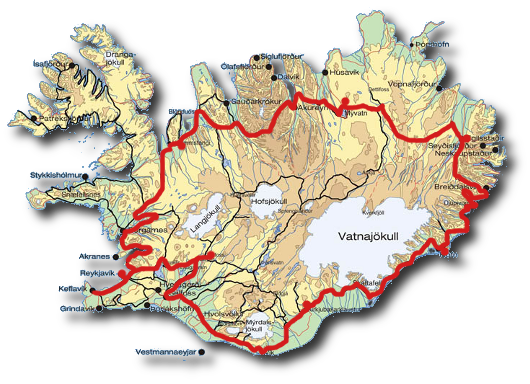Roads in Iceland
A large portion of Iceland's road system is made up of gravel roads, even some of the main highways, and more so as you get further away from Reykjavik and larger towns. The main highway around Iceland, Route 1, or Ring Road, circumnavigates Iceland in 1,332 kilometres of which 33 km is dirt road. Most of the population lives in or around Reykjavik so the further you get from the capital the less traffic you’ll meet. On gravel roads you may encounter stretches with potholes or “washboards” and occasionally some sand, but mostly the roads are good. Off road driving is prohibited because the soil and vegetation is very sensitive to all traffic. Even hikers can cause permanent damage to the land, which may recover only slowly or not at all.
The Icelandic Road Administration (Vegagerðin) has a website with maps and excellent information on current road conditions, including the interior highlands; weather conditions on certain mountain roads, safety information, webcam locations and lots more. If you intend to drive in Iceland, please visit the Icelandic Road and Coastal Administration website.
Before your journey, please ensure that you check the current situation for all main roads provided by the Icelandic Road and Coastal Administration.
Icelandic roads can be dangerous, especially for those unfamiliar with them and unused to travelling in uninhabited areas and rough country. In terms of driving speed limits, the following applies:
- The speed limit in populated areas is usually 50 km/h;
- The speed limit is often 60 km/h on thruways, but in residential areas it is usually only 30 km/h;
- The main rule in rural areas is that gravel roads have a speed limit of 80 km/h, and paved roads 90 km/h;
- Signs indicate if other speed limits apply.
The Icelandic Road Traffic Directorate (Umferðarstofa) has produced a video entitled “How to Drive in Iceland”, as well as a downloadable brochure in English, German and French, which can be accessed on their website.
The Interior Highlands
The mountain roads across the interior highlands are closed until late June. They are rough, with lots of steep hills and unbridged rivers. In the interior, there are no shops so you must bring enough food. The Icelandic Touring Association (Ferðafélag Íslands) is the biggest travel association in Iceland and it runs shelters and 38 mountain huts in numerous places in the Icelandic interior. However, they are often full, need to be booked long in advance and accommodation is not guaranteed. Some areas are protected areas where you must camp at designated campsites. Elsewhere you can rough camp almost anywhere except on private land, provided you don’t leave any marks or litter. Ask permission if you think the spot is privately owned.
Most rivers are unbridged and at over 40 fords, notices have been put up with instructions on how to ford rivers. Be sure to assess the strength of the current, depth and the nature of the riverbed before fording a river. If a river looks dangerous to cross, it probably is, and if you are traveling by yourself you should wait for someone who could keep an eye out and help you or get help if you run into trouble. Glacial rivers swell as the day progresses and can be a lot more dangerous than they look.
Check the weather forecast before heading into the interior highlands and every day while there. The weather can change very suddenly. You should also ask the wardens in the huts, and others, about conditions ahead. Sometimes rivers flood and bridges and roads are closed. In most areas you will find small rivers with fresh spring water every few hours but in certain areas you may have to stock up on water for two days.
The Icelandic Association for Search & Rescue, ICE-SAR (Landsbjörg), provides vital information for safe travel in Iceland on their website. It is imperative to be well informed when travelling around Iceland, especially in the highlands, since the unfamiliar terrain and the abrupt weather changes can otherwise prove hazardous. Travellers should prepare well for each trip and know its route conditions. This is the best way to prevent accidents and ensure a safe and pleasant journey.
